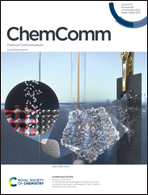Ligand-controlled, Pd/CuH-catalyzed reductive cross-coupling of terminal alkenes and N-heteroaryl bromides†
Abstract
The reductive cross-coupling of terminal alkenes and N-heterocyclic bromides has been demonstrated by ligand optimization of Pd and CuH catalysis. The optimized ligands are Briphos, a π-acceptor monodentate phosphorus ligand, for Pd catalysis and DTB-DPPBz, a sterically bulky bidentate phosphorus ligand, for CuH catalysis. These conditions were further applied to the gram-scale production of clathryimine B.



 Please wait while we load your content...
Please wait while we load your content...